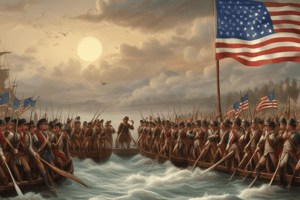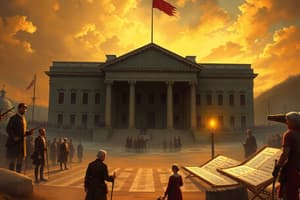Podcast
Questions and Answers
Which of the following was a significant limitation of the Articles of Confederation that directly led to international trade issues?
Which of the following was a significant limitation of the Articles of Confederation that directly led to international trade issues?
- The inability of the national government to declare war.
- The individual states imposing their own tariffs. (correct)
- The requirement for unanimous consent to amend the Articles.
- The lack of a national judiciary to resolve interstate disputes.
How did the Northwest Ordinance of 1787 address the issue of slavery in the newly formed territories?
How did the Northwest Ordinance of 1787 address the issue of slavery in the newly formed territories?
- It mandated the gradual abolition of slavery over a period of ten years.
- It allowed each territory to decide on the issue of slavery through popular sovereignty.
- It outlawed slavery in the new states created between the Ohio and Mississippi rivers. (correct)
- It permitted slavery only in territories south of the Ohio River.
Which event highlighted the weakness of the Articles of Confederation and prompted calls for a stronger national government?
Which event highlighted the weakness of the Articles of Confederation and prompted calls for a stronger national government?
- The Boston Tea Party.
- Shays’ Rebellion. (correct)
- The XYZ Affair.
- The Whiskey Rebellion.
What was the primary concern of government bondholders that led to the need for the Constitutional Convention?
What was the primary concern of government bondholders that led to the need for the Constitutional Convention?
How did the Virginia Plan and the New Jersey Plan differ in their proposed structures for the national legislature?
How did the Virginia Plan and the New Jersey Plan differ in their proposed structures for the national legislature?
What was the significance of the 3/5ths Compromise?
What was the significance of the 3/5ths Compromise?
Which principle of the Constitution ensures that the power of government is divided between the national and state levels?
Which principle of the Constitution ensures that the power of government is divided between the national and state levels?
Which of the following best describes the checks and balances system established by the Constitution?
Which of the following best describes the checks and balances system established by the Constitution?
Why did the framers of the Constitution implement the Electoral College?
Why did the framers of the Constitution implement the Electoral College?
What was the primary argument presented in the Federalist Papers?
What was the primary argument presented in the Federalist Papers?
Which group believed that smaller, more local governments were better able to protect the rights of the people?
Which group believed that smaller, more local governments were better able to protect the rights of the people?
What was the result of the Annapolis meeting in 1786?
What was the result of the Annapolis meeting in 1786?
Which of the following proposals called for a two-house legislature with representation based on state population?
Which of the following proposals called for a two-house legislature with representation based on state population?
How did the Great Compromise reconcile the differing interests of large and small states during the Constitutional Convention?
How did the Great Compromise reconcile the differing interests of large and small states during the Constitutional Convention?
How did the structure of the government under the Articles of Confederation contribute to its weakness?
How did the structure of the government under the Articles of Confederation contribute to its weakness?
What was the long-term impact of Shays' Rebellion on the United States?
What was the long-term impact of Shays' Rebellion on the United States?
Which of the following was a key accomplishment of the government under the Articles of Confederation?
Which of the following was a key accomplishment of the government under the Articles of Confederation?
How did the Anti-Federalists view the new Constitution?
How did the Anti-Federalists view the new Constitution?
How does the principle of separation of powers function within the structure of the U.S. government?
How does the principle of separation of powers function within the structure of the U.S. government?
How did the Constitution address the concerns about excessive democracy and potential radicalism?
How did the Constitution address the concerns about excessive democracy and potential radicalism?
Flashcards
Articles of Confederation
Articles of Confederation
Initial government by Continental Congress, replaced by the U.S. Constitution.
Legislative Structure under the Articles
Legislative Structure under the Articles
Each state had one vote in a single-house body.
Powers Granted to Congress Under the Articles
Powers Granted to Congress Under the Articles
Congress could declare war, conduct foreign affairs, and coin money.
Limitations of Congress
Limitations of Congress
Signup and view all the flashcards
Northwest Ordinance of 1787
Northwest Ordinance of 1787
Signup and view all the flashcards
Shays' Rebellion
Shays' Rebellion
Signup and view all the flashcards
What was Shays’ Rebellion?
What was Shays’ Rebellion?
Signup and view all the flashcards
Major Weakness of the Articles
Major Weakness of the Articles
Signup and view all the flashcards
Constitutional Convention
Constitutional Convention
Signup and view all the flashcards
Goal of the Constitutional Convention
Goal of the Constitutional Convention
Signup and view all the flashcards
Virginia Plan
Virginia Plan
Signup and view all the flashcards
New Jersey Plan
New Jersey Plan
Signup and view all the flashcards
The Great Compromise
The Great Compromise
Signup and view all the flashcards
3/5ths Compromise
3/5ths Compromise
Signup and view all the flashcards
Principles of the Constitution
Principles of the Constitution
Signup and view all the flashcards
Three Branches of Government
Three Branches of Government
Signup and view all the flashcards
Federalism
Federalism
Signup and view all the flashcards
Electoral College
Electoral College
Signup and view all the flashcards
Federalist Papers
Federalist Papers
Signup and view all the flashcards
Anti-Federalists
Anti-Federalists
Signup and view all the flashcards
Study Notes
Articles of Confederation
- The Articles of Confederation was the initial government established by the Continental Congress.
- It preceded the U.S. Constitution and was in effect until 1788.
- It was considered a weak framework for a national government.
- Described as a "firm league of friendship" among the states.
- Consisted of a one-house body of delegates with each state having a single vote.
- There was no president nor a judiciary branch.
- Decisions required 9 out of 13 congressional votes.
- Congress was limited in its powers – could declare war, conduct foreign affairs, and coin money.
- It could not collect taxes; this was left to the states.
- Amendments required a unanimous vote, resulting in zero amendments being passed.
- The government was deliberately weak due to fears of tyrannical governments.
- It did achieve victory in the war and developed rules for dealing with the Northwest Territory (Ohio).
- It established rules with the Northwest Ordinance of 1787 to create five new states between the Ohio and Mississippi rivers.
- The ordinance acknowledged American Indian land claims and outlawed slavery in the new states.
- A major downfall was the inability to collect taxes.
- States individually imposed tariffs, leading to international trade issues.
- Shays’ Rebellion in Massachusetts, an uprising of indebted farmers, highlighted the government's weakness.
Shays' Rebellion
- Shays' Rebellion was an uprising in Massachusetts (1786-1787) led by Revolutionary War veteran Daniel Shays.
- Farmers closed the courts to prevent them from foreclosing upon their debt-encumbered farms.
- The state militia quelled the uprising, but it signaled the Articles government's ineffectiveness.
- Thomas Jefferson favored the rebellion.
- Elites viewed it as a threat to private property due to excessive democratic liberty among the lower classes.
- Government bondholders were concerned about not getting paid back due to lack of tax revenue.
Constitutional Convention
- An Annapolis meeting in 1786 aimed to regulate international trade led to the Constitutional Convention in Philadelphia.
- Delegates met in Philadelphia in 1787 to "revise" the Articles of Confederation but instead created a new Constitution.
- The 55 men were mostly wealthy and well-educated.
- They desired a stronger national government with executive, legislative, and judicial branches.
- The government should be republican, with representatives instead of direct democracy.
- Alexander Hamilton proposed life terms for the President and Senate, but this was rejected.
- The goal was to protect against tyranny by both the government and the people.
- Presidents are technically elected by the Electoral College, not directly by regular people.
Key Conflicts and Compromises
- A conflict arose between states with large populations and those with small populations.
- Large states supported the Virginia Plan proposing a two-house legislature with proportional representation.
- Smaller states supported the New Jersey Plan with a single legislative house and equal representation for each state.
- The Great Compromise, brokered by Roger Sherman of Connecticut, created a House of Representatives (proportional representation) and a Senate (two members per state).
- House members (Congressmen) served two-year terms, while Senators served six-year terms (1/3 up for election every 2 years).
- The 3/5ths Compromise determined that for population purposes, the total number of white people plus 3/5ths the population of "other persons" (slaves) would be counted.
- The Constitution also contained a fugitive slave clause, requiring escaped slaves to be returned to their masters.
Principles of the Constitution
- To avoid tyranny, the Constitution embraced separation of powers and federalism.
- The government was divided into three branches: legislative, executive, and judiciary.
- Checks and balances were incorporated to limit the power of each branch.
- The legislature can make laws, but the president can veto them.
- The judiciary can declare laws void (a power they granted themselves).
- Federalism is the idea that governmental authority rests both in the national and state governments.
- As an American, one is a citizen of both the United States and of their state.
- The national government is limited in scope to certain enumerated powers.
- Most other powers, especially the protection of health, safety, and morals, are left to the states.
Safeguards Against Radicalism
- The framers worried about the people voting for politicians in favor of redistributing property.
- Senators were elected by the states, typically by state legislatures.
- The Electoral College served as another hedge against too much democracy.
- Electors were supposed to be prominent, educated men of property.
Ratification and the Federalist Papers
- 9 out of the 13 states were required to ratify the Constitution in special conventions.
- Alexander Hamilton, James Madison, and John Jay wrote 85 essays known as the Federalist Papers to convince delegates to vote for it.
- The essays argued for a strong national government that wouldn't threaten people's liberty.
Anti-Federalists
- Anti-Federalists were supported by common people and small farmers.
- They saw less need for a strong national government to foster trade and protect creditors.
- They feared a strong government, especially one dominated by the wealthy.
- They believed that smaller, more local governments were more responsive to the people and better able to protect their rights.
- They preferred state governments.
Studying That Suits You
Use AI to generate personalized quizzes and flashcards to suit your learning preferences.




